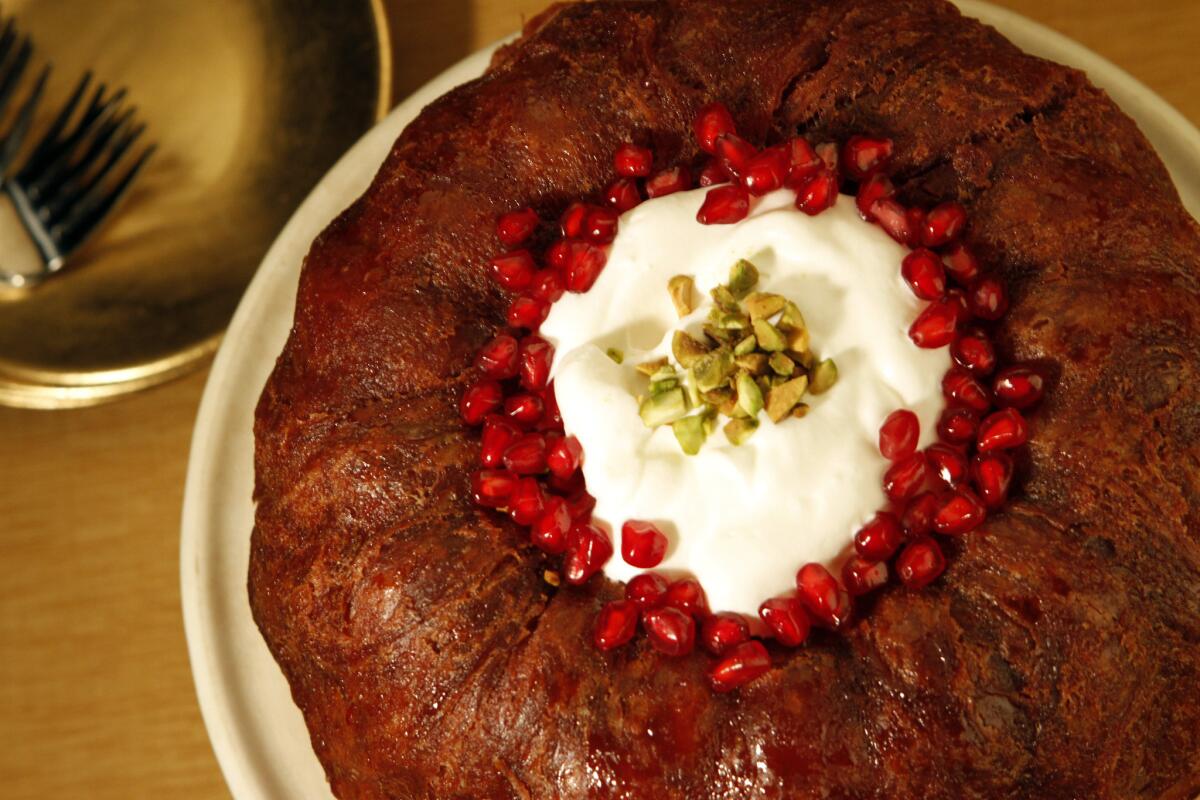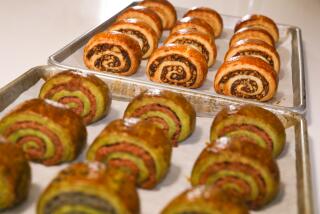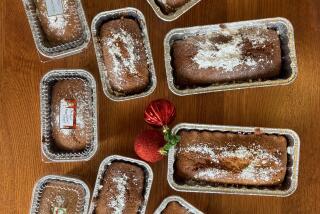Recipe: Pomegranate sabrina

Pomegranate sabrina
1 hour, plus rising and cooling times. Serves 10 to 12
Pomegranate syrup
2 cups pomegranate juice
1 cup plus 2 tablespoons sugar
2 strips of lemon zest (about 2 inches long)
2 strips of orange zest (about 2 inches long)
In a heavy-bottomed saucepan, combine the pomegranate juice, the sugar and the orange and lemon zest strips. Cook the mixture over low heat, stirring gently until the sugar dissolves, then increase the heat to high and bring to a boil. Remove from heat and set aside.
Cake
1/4 cup warm water (105 to 115 degrees)
1 (¼ ounce) packet dry yeast
1 tablespoon plus 1 teaspoon sugar, divided
2 to 2½ cups (8½ to 11 ounces) flour, more if needed
1 teaspoon salt
4 eggs
1 teaspoon grated lemon zest
7 tablespoons (3½ ounces) butter or unsalted nondairy stick margarine, cut in small pieces, at room temperature
Whipped cream (or whipped nondairy cream), for garnish
Pomegranate arils, for garnish
Chopped pistachios, for garnish
1. Activate the yeast: Place the warm water in a small bowl and sprinkle over the yeast, along with 1 teaspoon sugar. Set aside until the yeast is foamy, about 10 minutes.
2. If using a food processor, combine the flour and salt in the bowl, preferably fitted with a plastic dough blade. Process the flour mixture briefly to mix, and transfer it to a bowl. Put the yeast mixture, the remaining tablespoon sugar and the eggs in the food processor and blend about 5 seconds. Add the flour mixture to the processor and process continuously for 30 seconds. Scrape down the sides and process the mixture about 5 seconds. Add the lemon zest and pulse a few times to blend it into the dough. The dough will be soft and very sticky.
If using a stand mixer, sift the 2 cups flour into the mixer bowl. Add 2 eggs, the salt and 1 tablespoon sugar. Mix with a dough hook or flat beater at low speed until a few tablespoons of the flour are drawn into the egg mixture. Add the yeast mixture and the remaining 2 eggs and mix at low speed until the dough is soft and smooth, about 10 minutes. Beat the dough at medium speed until it is very smooth and most of it comes away from sides of bowl and wraps around the beater, adding additional flour if needed, about 12 minutes.
To mix by hand, sift the flour into a large bowl and make a well in center. Add 2 eggs, the salt and 1 tablespoon sugar to the well, and mix them using a wooden spoon, gradually drawing in 2 or 3 tablespoons flour. Add the remaining 2 eggs and the yeast mixture to the well. Stir to a soft dough. With your cupped hand under the dough, slap the dough against the bowl for about 1 minute, or until it is smooth, working in additional flour if needed to obtain the right consistency.
3. Lightly oil a medium-sized bowl. Transfer the dough to the oiled bowl. Put the butter pieces side by side on top of the dough. Cover the dough with plastic wrap or with a lightly dampened towel. Let the dough rise in a warm, draft-free area until it doubles in volume, about 1 hour.
4. Beat the butter pieces into the dough with a wooden spoon until they are completely blended in.
5. Generously butter a 5-cup ring mold or bundt pan. Transfer the dough to the mold. Using a rubber spatula, smooth the dough in an even layer. Cover the dough with plastic wrap and let it rise in a warm, draft-free place 30 minutes. Remove the covering and let the dough rise to the top of the mold, about 15 to 30 minutes.
6. Position a rack in the center of the oven and heat to 400 degrees. Bake the cake until the top browns and a cake tester inserted into the cake comes out clean, about 16 to 22 minutes. Unmold the cake onto a rack; if necessary, run a metal spatula or thin-bladed knife around the outer and inner edges to release the cake from the mold. Let the cake stand until completely cool.
7. Remove the citrus zest strips from the syrup with a slotted spoon. To moisten the cake, reheat the syrup to a simmer. Remove it from the heat.
8. Put the cake, still on its rack (and with its firm crust side still facing down), in a roasting pan. Slowly and evenly ladle the hot syrup over the cake until it has absorbed as much syrup as possible. Let the cake stand about 2 minutes. Pour the syrup from the roasting pan into the saucepan. If the sides of the cake appear dry, gently brush syrup over them. Reheat the syrup nearly to a simmer and remove it from the heat. Ladle the syrup slowly over the cake again. If necessary, repeat the reheating and moistening of the cake until most of the syrup is absorbed. Let the cake stand on the rack to drain 30 minutes. Carefully transfer the cake to a platter, using 2 wide metal spatulas.
9. Gently spoon enough whipped cream into the ring-shaped cake’s center to fill it. Garnish the cream with a sprinkling of chopped pistachios and pomegranate arils. Serve each slice of cake with a spoonful of pomegranate arils and a dollop of whipped cream sprinkled with pistachios. Serve any remaining pomegranate arils, pistachios and whipped cream separately.
EACH OF 12 SERVINGS
Calories 272
Protein 5 grams
Carbohydrates 44 grams
Fiber 1 gram
Fat 9 grams
Saturated fat 5 grams
Cholesterol 80 mg
Sugar 26 grams
Sodium 223 mg
NOTE: Sabrina is a sweet, yeast-leavened cake similar to French savarin that was a favorite of ours when we lived in Israel. In this recipe the syrup is made with pomegranate juice instead of water. For a kosher meal that includes meat, make the cake with nondairy margarine and use nondairy cream to make the whipped cream. If you like, serve the sabrina with sliced pomegranate-poached pears.
More to Read
Eat your way across L.A.
Get our weekly Tasting Notes newsletter for reviews, news and more.
You may occasionally receive promotional content from the Los Angeles Times.









